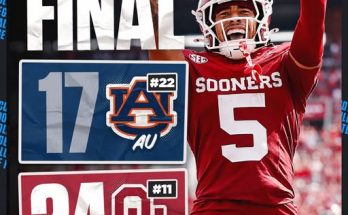Here’s an in-depth, roughly 1 500‑word article exploring why Alabama football spent approximately $23 million more on coach pay than any other SEC program in fiscal year 2024, exploring the financial context, coaching carousel, contracts, staff structure, and strategic intent—without subheadings, as requested.
Why did Alabama spend so much on coach compensation during FY 2024? The primary catalyst was the retirement of legendary head coach Nick Saban in January 2024 and the ensuing hiring of Kalen DeBoer, which triggered one of the most expensive coaching transitions in collegiate sports. For context, Alabama’s total athletics department expenses in FY 2024 were $262.8 million against $234.8 million in revenue—a deficit of nearly $28 millionen.wikipedia.org+8sportingnews.com+8mentonealabama.org+8. The single largest component of this surge was coach compensation. Prior to the transition, Alabama already had high annual coaching expenses; in the fiscal period ending June 30, 2024, the football program alone spent $113.8 million overall while coach salaries rose from $22 million to $49.3 million. Combined with high assistant salaries, football coaching costs skyrocketed.
Kalen DeBoer’s contract exemplifies this shift. Approved by the University of Alabama Board of Trustees in March 2024, DeBoer was contracted for eight years at $10 million in his first year, rising by $250 000 annually to $11.75 million in year eighttdalabamamag.com+15si.com+15chron.com+15businessinsider.com+10africa.espn.com+10tdalabamamag.com+10. The deal includes robust guarantees—90 percent guaranteed salary and a buyout schedule ranging from $5 million in 2024 down to zero after 2026africa.espn.com+1si.com+1. Incentive bonuses include up to $875 000 for a national championship, plus incentives for SEC titles, Playoff appearances, and academic benchmarksmentonealabama.org+18si.com+18africa.espn.com+18. Averaged over eight years, his annual compensation equates to $10.875 million, placing DeBoer among the top five highest‑paid head coaches in college footballrocketswire.usatoday.com+13the-sun.com+13si.com+13.
Even before DeBoer’s arrival, assistant coaching was a major financial commitment. USA Today data shows Alabama’s assistants’ salaries totaled approximately $9.475 million in FY 2024tdalabamamag.com+2rolltidewire.usatoday.com+2rocketswire.usatoday.com+2. Key positions carried seven-figure salaries: defensive coordinator Kane Wommack earned $1.55 million, offensive coordinator Nick Sheridan $1.35 million, wide receivers coach JaMarcus Shephard $1.1 million, and defensive line coach Freddie Roach $1 millionsi.com+5tdalabamamag.com+5rolltidewire.usatoday.com+5. Strength & conditioning coach David Ballou earned $950 000, the second‑highest in college footballsi.com+4rocketswire.usatoday.com+4rolltidewire.usatoday.com+4. These elevated salaries reflect Alabama’s strategy of assembling an elite coaching staff to support DeBoer in his inaugural campaign.
By comparison, the typical SEC program spends far less on coaches. For instance, in FY 2024 prior to Alabama’s transition, Texas A&M’s coach salaries were $19.4 million, but with severances (e.g., Jimbo Fisher’s buyout) A&M spent $47 millionmentonealabama.org+17chron.com+17rolltidewire.usatoday.com+17—still less focused solely on salaries. Texas, meanwhile, spent $22.9 million on coaches’ salaries under Steve Sarkisianchron.com. Georgia, LSU, and Florida also pay their coordinators in the low single‑million dollar range, but none match the tier of Alabama’s support structure.
An older ranking illustrates the contrast. Before DeBoer’s arrival, Alabama paid roughly $7.8 million combined for football and men’s basketball head coaches—Nick Saban at $6 million plus a million in bonuses, and Anthony Grant in basketball at $1.8 millionfoxsports.com. That already placed Alabama atop SEC head coach payouts before assistant salaries. But FY 2024’s total—DeBoer’s base plus assistants—approached $60 million just for football coaches ($49.3 million on head coach plus estimated assistant total).
Why such willingness to spend? Alabama sits atop the SEC athletic revenue rankings. In the 2022 fiscal report, Alabama’s athletic revenues were the highest among public SEC schools at $214 million, with Georgia a close second at $203 million. Football alone generated $130.9 million, making up some 60 percent of athletic revenue. This financial prowess gives Alabama greater capacity to invest heavily in coaching, enabling it to outbid rivals for elite talent and retain staff.
The timing and nature of the Saban-to‑DeBoer transition also drove costs. Nick Saban’s legacy elevated expectations and raised the cost of replacing him. DeBoer commanded a top‑tier salary commensurate with what Georgia’s Kirby Smart and Clemson’s Dabo Swinney earnen.wikipedia.org+17the-sun.com+17foxsports.com+17. Beyond DeBoer, bringing in an experienced, multi‑million dollar assistant staff further inflated costs. That includes 2‑three‑year guarantees for Wommack ($1.55 M rising to $1.85 M) and Sheridan ($1.35 M rising)wvua23.com+4tdalabamamag.com+4rolltidewire.usatoday.com+4.
It wasn’t just the football budget impacted. The athletics department’s broader deficit stems from combined sports coaching and operational expenses. Yellowhammer News reports $65 million in total coaching salaries across all sports and $41 million in support staff payyellowhammernews.com. The athletics deficit of $28 million in FY 2024 owed heavily to one-time costs tied to the football coaching transitionsportingnews.com+1yellowhammernews.com+1. Despite increasing revenue (from $129 million to $140 million YoY), expenses rose even more sharply—from $83 million to $113 million—mainly driven by compensationyellowhammernews.com.
This expense spike stands in sharp contrast to Texas’s experience. While Texas topped SEC revenue at $331.9 million in FY 2024, it spent only $22.9 million on coaches’ salaries and severancechron.com. This left Texas with a $6.9 million profit, in contrast to Alabama’s $27 million losschron.com. The divergence stems from differing personnel strategies: Texas retained coaching continuity under Sarkisian, while Alabama undertook an extensive hiring process.
Critics will argue that this is fiscal overreach, especially amid pressure on university budgets, tuition rates, and public perception. Operating at a $28 million deficit—even a planned, transitional one—draws scrutiny. But for many in Tuscaloosa, this level of investment is essential to maintain the “Bama Standard.” AD Greg Byrne publicly appealed for additional donor support to offset the costs of competitiveness during this transitionchron.comsportingnews.com.
Strategically, Alabama has fewer grants of competitive advantage: prestige, recruiting pipeline, stadium capacity, and – until recently – coaching stability. The departure of Saban risked disrupting decades of dominance. To minimize that, Alabama replaced him with an elite coach on the highest possible contract and surrounded him with a staff paid well above SEC norms, aiming to avoid a performance dip under DeBoer’s first season. It was a deliberate, high‑cost hedge against instability.
It is notable that assistant coach salaries elsewhere in the SEC remain below Alabama’s. Florida spent only $6.565 million on assistants in FY 2024, ranking 11th in public schoolsrocketswire.usatoday.com, while Georgia led with $10.332 million, itself dwarfed by Alabama’s five‑plus million on just two coordinators and more than $9 million overall assistant commitmentrocketswire.usatoday.com.
Looking forward, Alabama’s high baseline in coach compensation may signal a new arms race. With NIL rules and conference realignment reshaping college football economics, programs seek hiring and retention strategies to protect brand value and performance. Though Alabama’s FY 2024 numbers appear extraordinary, they may become the new normal in elite programs—particularly in the SEC, where coaches ranking among the top nationally is increasingly expected.
In summary, Alabama’s $23 million-plus lead in coach pay over its closest SEC rivals in FY 2024 boils down to a perfect storm: the retirement of Nick Saban, the hiring of Kalen DeBoer on a top-tier contract, and a full-staff rebuild with seven‑figure salaries targeting high-caliber assistants. These moves, while expensive, reflect Alabama’s financial capacity and strategic calculation to preserve its elite standing. Though it resulted in a historic deficit, long-term stakeholders view it as a necessary short-term investment to keep “the Tide” rolling at full speed.



